Gibbs reflective cycle - Article Review
VerifiedAdded on 2022/08/18
|9
|2548
|31
AI Summary
Contribute Materials
Your contribution can guide someone’s learning journey. Share your
documents today.
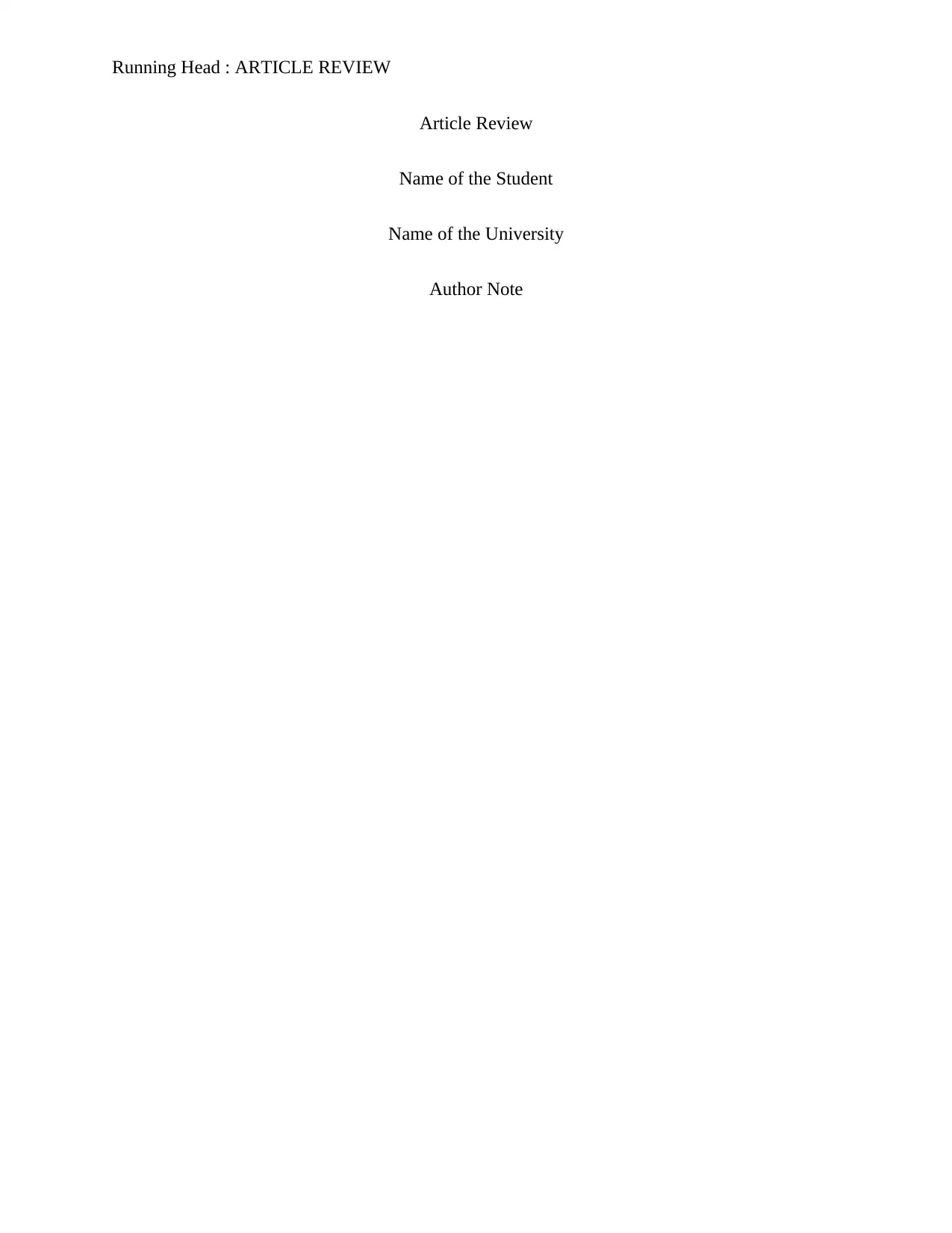
Running Head : ARTICLE REVIEW
Article Review
Name of the Student
Name of the University
Author Note
Article Review
Name of the Student
Name of the University
Author Note
Secure Best Marks with AI Grader
Need help grading? Try our AI Grader for instant feedback on your assignments.
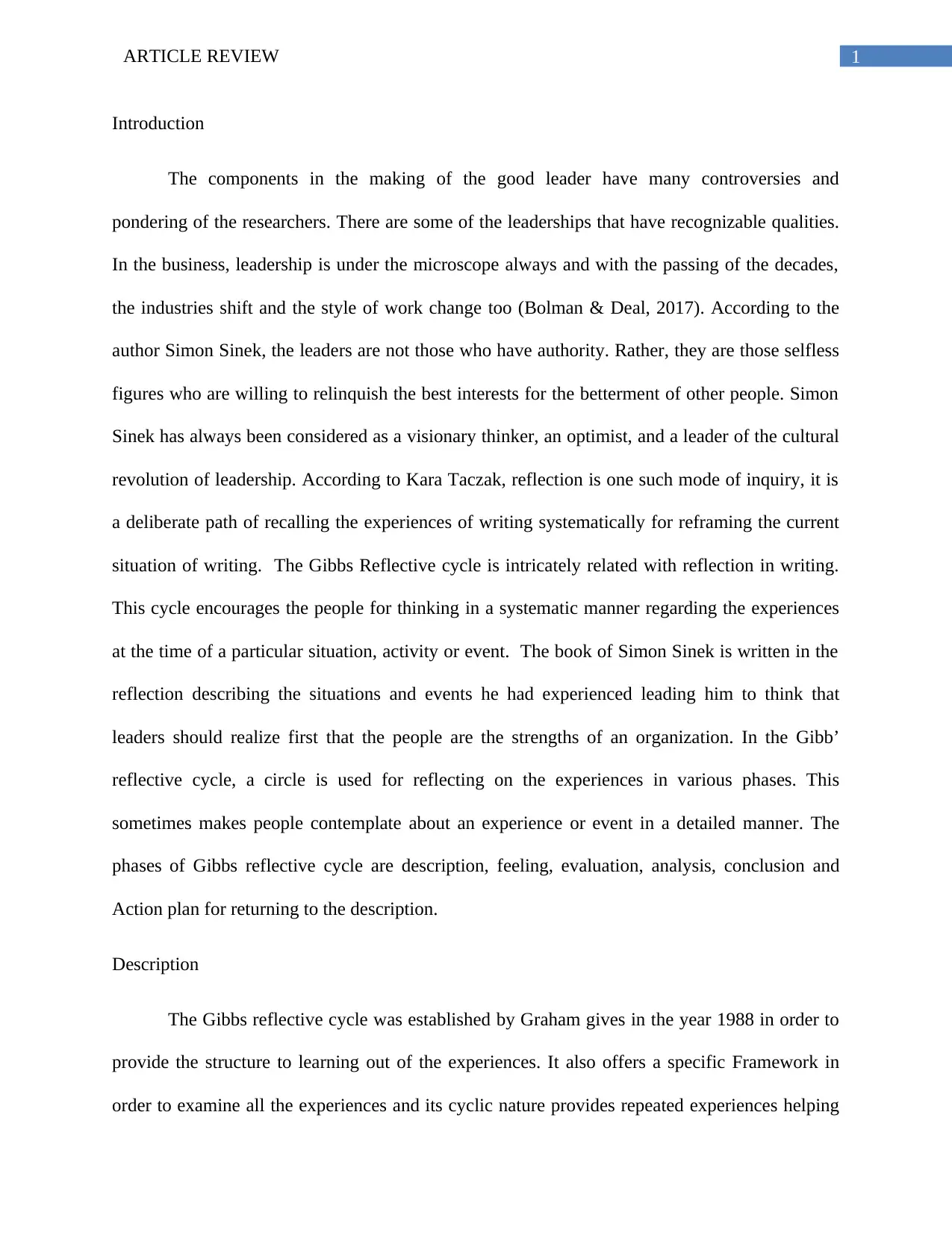
1ARTICLE REVIEW
Introduction
The components in the making of the good leader have many controversies and
pondering of the researchers. There are some of the leaderships that have recognizable qualities.
In the business, leadership is under the microscope always and with the passing of the decades,
the industries shift and the style of work change too (Bolman & Deal, 2017). According to the
author Simon Sinek, the leaders are not those who have authority. Rather, they are those selfless
figures who are willing to relinquish the best interests for the betterment of other people. Simon
Sinek has always been considered as a visionary thinker, an optimist, and a leader of the cultural
revolution of leadership. According to Kara Taczak, reflection is one such mode of inquiry, it is
a deliberate path of recalling the experiences of writing systematically for reframing the current
situation of writing. The Gibbs Reflective cycle is intricately related with reflection in writing.
This cycle encourages the people for thinking in a systematic manner regarding the experiences
at the time of a particular situation, activity or event. The book of Simon Sinek is written in the
reflection describing the situations and events he had experienced leading him to think that
leaders should realize first that the people are the strengths of an organization. In the Gibb’
reflective cycle, a circle is used for reflecting on the experiences in various phases. This
sometimes makes people contemplate about an experience or event in a detailed manner. The
phases of Gibbs reflective cycle are description, feeling, evaluation, analysis, conclusion and
Action plan for returning to the description.
Description
The Gibbs reflective cycle was established by Graham gives in the year 1988 in order to
provide the structure to learning out of the experiences. It also offers a specific Framework in
order to examine all the experiences and its cyclic nature provides repeated experiences helping
Introduction
The components in the making of the good leader have many controversies and
pondering of the researchers. There are some of the leaderships that have recognizable qualities.
In the business, leadership is under the microscope always and with the passing of the decades,
the industries shift and the style of work change too (Bolman & Deal, 2017). According to the
author Simon Sinek, the leaders are not those who have authority. Rather, they are those selfless
figures who are willing to relinquish the best interests for the betterment of other people. Simon
Sinek has always been considered as a visionary thinker, an optimist, and a leader of the cultural
revolution of leadership. According to Kara Taczak, reflection is one such mode of inquiry, it is
a deliberate path of recalling the experiences of writing systematically for reframing the current
situation of writing. The Gibbs Reflective cycle is intricately related with reflection in writing.
This cycle encourages the people for thinking in a systematic manner regarding the experiences
at the time of a particular situation, activity or event. The book of Simon Sinek is written in the
reflection describing the situations and events he had experienced leading him to think that
leaders should realize first that the people are the strengths of an organization. In the Gibb’
reflective cycle, a circle is used for reflecting on the experiences in various phases. This
sometimes makes people contemplate about an experience or event in a detailed manner. The
phases of Gibbs reflective cycle are description, feeling, evaluation, analysis, conclusion and
Action plan for returning to the description.
Description
The Gibbs reflective cycle was established by Graham gives in the year 1988 in order to
provide the structure to learning out of the experiences. It also offers a specific Framework in
order to examine all the experiences and its cyclic nature provides repeated experiences helping
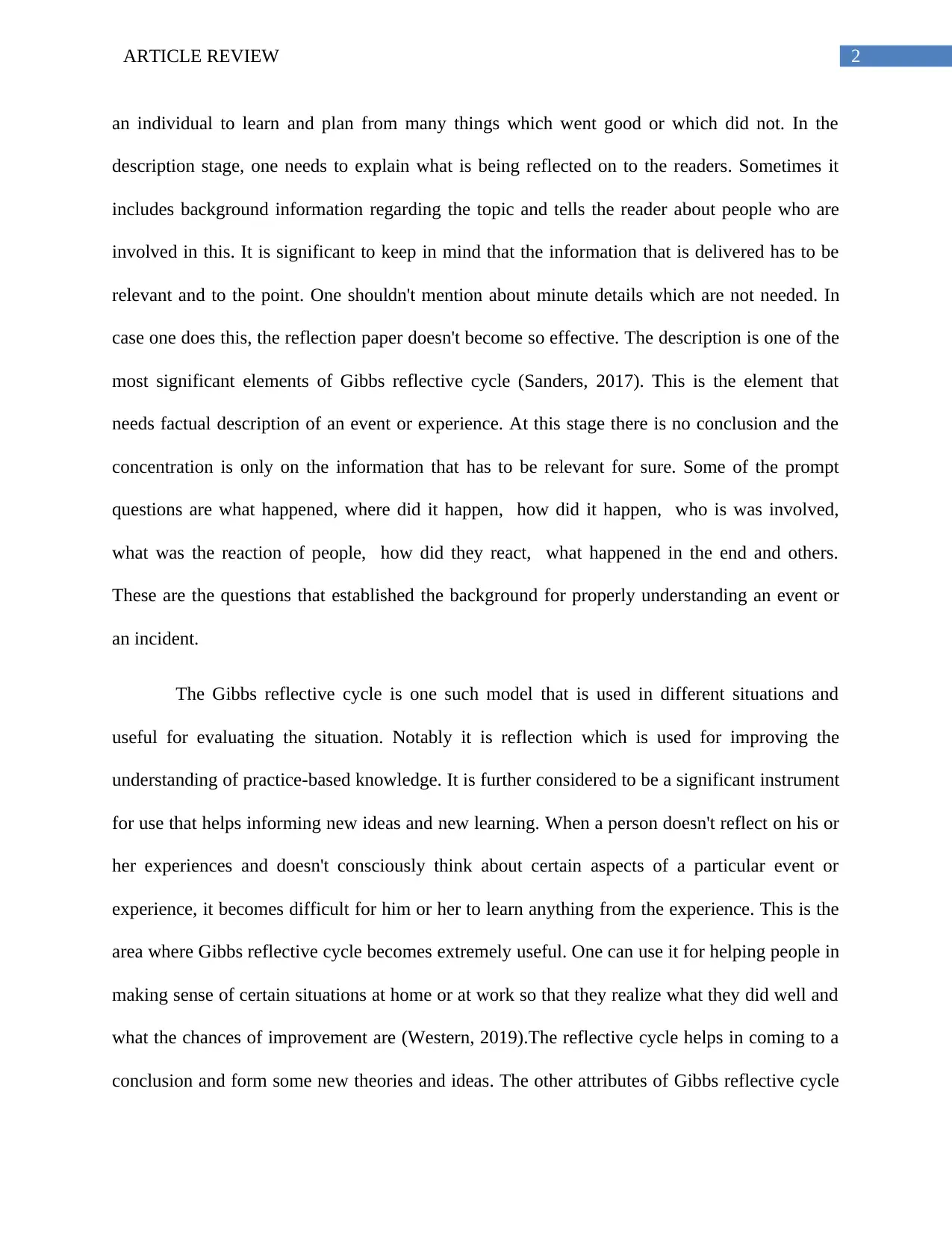
2ARTICLE REVIEW
an individual to learn and plan from many things which went good or which did not. In the
description stage, one needs to explain what is being reflected on to the readers. Sometimes it
includes background information regarding the topic and tells the reader about people who are
involved in this. It is significant to keep in mind that the information that is delivered has to be
relevant and to the point. One shouldn't mention about minute details which are not needed. In
case one does this, the reflection paper doesn't become so effective. The description is one of the
most significant elements of Gibbs reflective cycle (Sanders, 2017). This is the element that
needs factual description of an event or experience. At this stage there is no conclusion and the
concentration is only on the information that has to be relevant for sure. Some of the prompt
questions are what happened, where did it happen, how did it happen, who is was involved,
what was the reaction of people, how did they react, what happened in the end and others.
These are the questions that established the background for properly understanding an event or
an incident.
The Gibbs reflective cycle is one such model that is used in different situations and
useful for evaluating the situation. Notably it is reflection which is used for improving the
understanding of practice-based knowledge. It is further considered to be a significant instrument
for use that helps informing new ideas and new learning. When a person doesn't reflect on his or
her experiences and doesn't consciously think about certain aspects of a particular event or
experience, it becomes difficult for him or her to learn anything from the experience. This is the
area where Gibbs reflective cycle becomes extremely useful. One can use it for helping people in
making sense of certain situations at home or at work so that they realize what they did well and
what the chances of improvement are (Western, 2019).The reflective cycle helps in coming to a
conclusion and form some new theories and ideas. The other attributes of Gibbs reflective cycle
an individual to learn and plan from many things which went good or which did not. In the
description stage, one needs to explain what is being reflected on to the readers. Sometimes it
includes background information regarding the topic and tells the reader about people who are
involved in this. It is significant to keep in mind that the information that is delivered has to be
relevant and to the point. One shouldn't mention about minute details which are not needed. In
case one does this, the reflection paper doesn't become so effective. The description is one of the
most significant elements of Gibbs reflective cycle (Sanders, 2017). This is the element that
needs factual description of an event or experience. At this stage there is no conclusion and the
concentration is only on the information that has to be relevant for sure. Some of the prompt
questions are what happened, where did it happen, how did it happen, who is was involved,
what was the reaction of people, how did they react, what happened in the end and others.
These are the questions that established the background for properly understanding an event or
an incident.
The Gibbs reflective cycle is one such model that is used in different situations and
useful for evaluating the situation. Notably it is reflection which is used for improving the
understanding of practice-based knowledge. It is further considered to be a significant instrument
for use that helps informing new ideas and new learning. When a person doesn't reflect on his or
her experiences and doesn't consciously think about certain aspects of a particular event or
experience, it becomes difficult for him or her to learn anything from the experience. This is the
area where Gibbs reflective cycle becomes extremely useful. One can use it for helping people in
making sense of certain situations at home or at work so that they realize what they did well and
what the chances of improvement are (Western, 2019).The reflective cycle helps in coming to a
conclusion and form some new theories and ideas. The other attributes of Gibbs reflective cycle
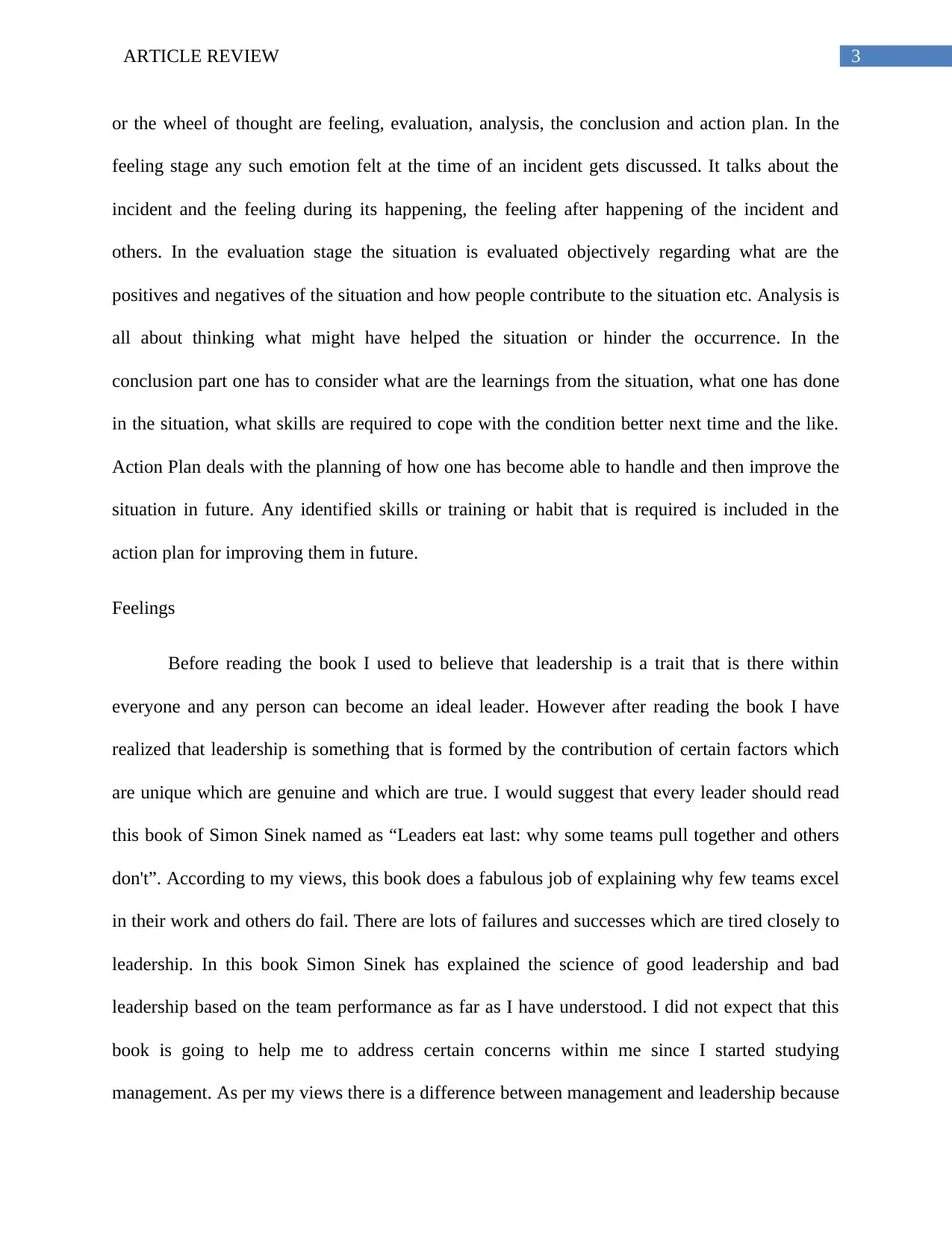
3ARTICLE REVIEW
or the wheel of thought are feeling, evaluation, analysis, the conclusion and action plan. In the
feeling stage any such emotion felt at the time of an incident gets discussed. It talks about the
incident and the feeling during its happening, the feeling after happening of the incident and
others. In the evaluation stage the situation is evaluated objectively regarding what are the
positives and negatives of the situation and how people contribute to the situation etc. Analysis is
all about thinking what might have helped the situation or hinder the occurrence. In the
conclusion part one has to consider what are the learnings from the situation, what one has done
in the situation, what skills are required to cope with the condition better next time and the like.
Action Plan deals with the planning of how one has become able to handle and then improve the
situation in future. Any identified skills or training or habit that is required is included in the
action plan for improving them in future.
Feelings
Before reading the book I used to believe that leadership is a trait that is there within
everyone and any person can become an ideal leader. However after reading the book I have
realized that leadership is something that is formed by the contribution of certain factors which
are unique which are genuine and which are true. I would suggest that every leader should read
this book of Simon Sinek named as “Leaders eat last: why some teams pull together and others
don't”. According to my views, this book does a fabulous job of explaining why few teams excel
in their work and others do fail. There are lots of failures and successes which are tired closely to
leadership. In this book Simon Sinek has explained the science of good leadership and bad
leadership based on the team performance as far as I have understood. I did not expect that this
book is going to help me to address certain concerns within me since I started studying
management. As per my views there is a difference between management and leadership because
or the wheel of thought are feeling, evaluation, analysis, the conclusion and action plan. In the
feeling stage any such emotion felt at the time of an incident gets discussed. It talks about the
incident and the feeling during its happening, the feeling after happening of the incident and
others. In the evaluation stage the situation is evaluated objectively regarding what are the
positives and negatives of the situation and how people contribute to the situation etc. Analysis is
all about thinking what might have helped the situation or hinder the occurrence. In the
conclusion part one has to consider what are the learnings from the situation, what one has done
in the situation, what skills are required to cope with the condition better next time and the like.
Action Plan deals with the planning of how one has become able to handle and then improve the
situation in future. Any identified skills or training or habit that is required is included in the
action plan for improving them in future.
Feelings
Before reading the book I used to believe that leadership is a trait that is there within
everyone and any person can become an ideal leader. However after reading the book I have
realized that leadership is something that is formed by the contribution of certain factors which
are unique which are genuine and which are true. I would suggest that every leader should read
this book of Simon Sinek named as “Leaders eat last: why some teams pull together and others
don't”. According to my views, this book does a fabulous job of explaining why few teams excel
in their work and others do fail. There are lots of failures and successes which are tired closely to
leadership. In this book Simon Sinek has explained the science of good leadership and bad
leadership based on the team performance as far as I have understood. I did not expect that this
book is going to help me to address certain concerns within me since I started studying
management. As per my views there is a difference between management and leadership because
Secure Best Marks with AI Grader
Need help grading? Try our AI Grader for instant feedback on your assignments.
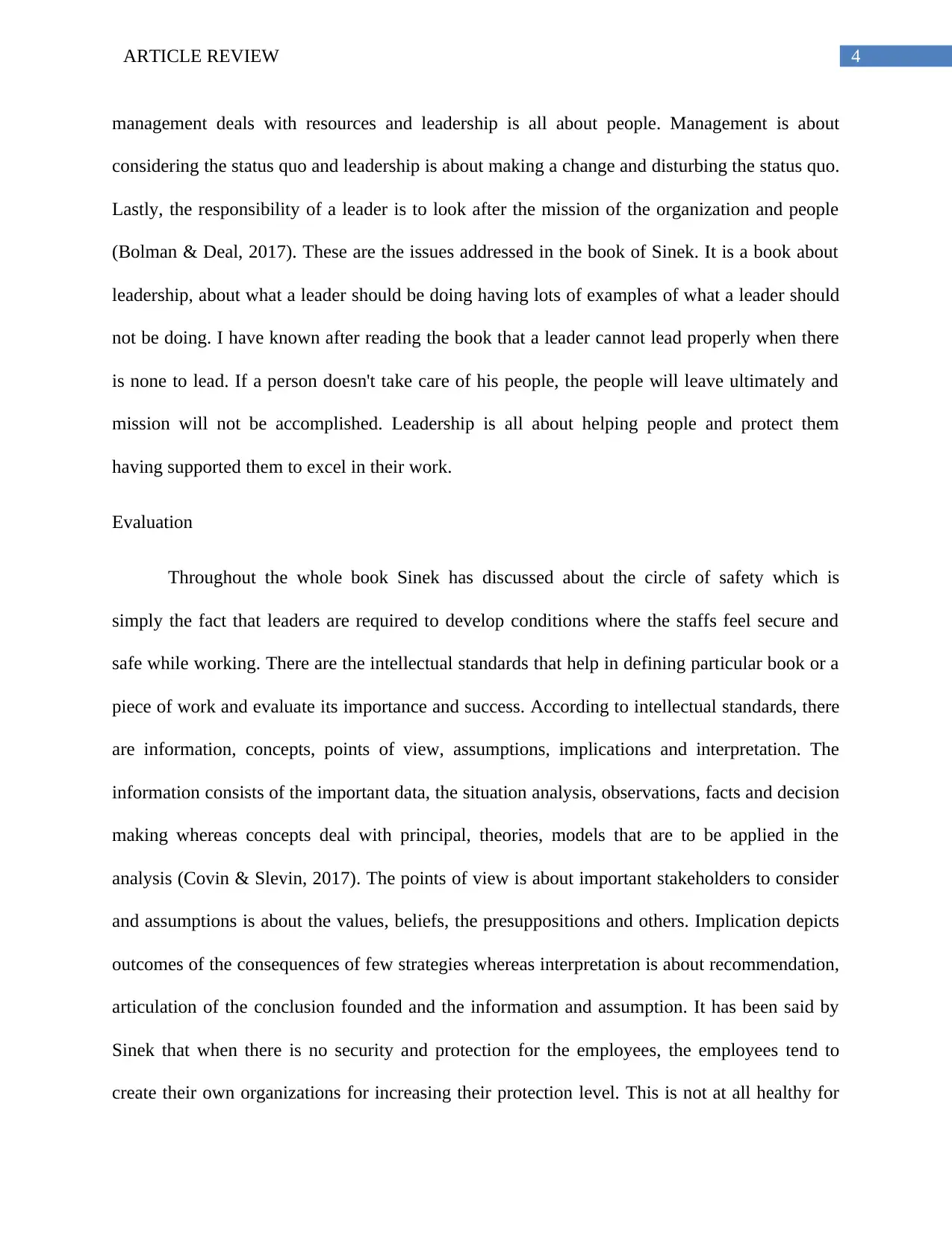
4ARTICLE REVIEW
management deals with resources and leadership is all about people. Management is about
considering the status quo and leadership is about making a change and disturbing the status quo.
Lastly, the responsibility of a leader is to look after the mission of the organization and people
(Bolman & Deal, 2017). These are the issues addressed in the book of Sinek. It is a book about
leadership, about what a leader should be doing having lots of examples of what a leader should
not be doing. I have known after reading the book that a leader cannot lead properly when there
is none to lead. If a person doesn't take care of his people, the people will leave ultimately and
mission will not be accomplished. Leadership is all about helping people and protect them
having supported them to excel in their work.
Evaluation
Throughout the whole book Sinek has discussed about the circle of safety which is
simply the fact that leaders are required to develop conditions where the staffs feel secure and
safe while working. There are the intellectual standards that help in defining particular book or a
piece of work and evaluate its importance and success. According to intellectual standards, there
are information, concepts, points of view, assumptions, implications and interpretation. The
information consists of the important data, the situation analysis, observations, facts and decision
making whereas concepts deal with principal, theories, models that are to be applied in the
analysis (Covin & Slevin, 2017). The points of view is about important stakeholders to consider
and assumptions is about the values, beliefs, the presuppositions and others. Implication depicts
outcomes of the consequences of few strategies whereas interpretation is about recommendation,
articulation of the conclusion founded and the information and assumption. It has been said by
Sinek that when there is no security and protection for the employees, the employees tend to
create their own organizations for increasing their protection level. This is not at all healthy for
management deals with resources and leadership is all about people. Management is about
considering the status quo and leadership is about making a change and disturbing the status quo.
Lastly, the responsibility of a leader is to look after the mission of the organization and people
(Bolman & Deal, 2017). These are the issues addressed in the book of Sinek. It is a book about
leadership, about what a leader should be doing having lots of examples of what a leader should
not be doing. I have known after reading the book that a leader cannot lead properly when there
is none to lead. If a person doesn't take care of his people, the people will leave ultimately and
mission will not be accomplished. Leadership is all about helping people and protect them
having supported them to excel in their work.
Evaluation
Throughout the whole book Sinek has discussed about the circle of safety which is
simply the fact that leaders are required to develop conditions where the staffs feel secure and
safe while working. There are the intellectual standards that help in defining particular book or a
piece of work and evaluate its importance and success. According to intellectual standards, there
are information, concepts, points of view, assumptions, implications and interpretation. The
information consists of the important data, the situation analysis, observations, facts and decision
making whereas concepts deal with principal, theories, models that are to be applied in the
analysis (Covin & Slevin, 2017). The points of view is about important stakeholders to consider
and assumptions is about the values, beliefs, the presuppositions and others. Implication depicts
outcomes of the consequences of few strategies whereas interpretation is about recommendation,
articulation of the conclusion founded and the information and assumption. It has been said by
Sinek that when there is no security and protection for the employees, the employees tend to
create their own organizations for increasing their protection level. This is not at all healthy for
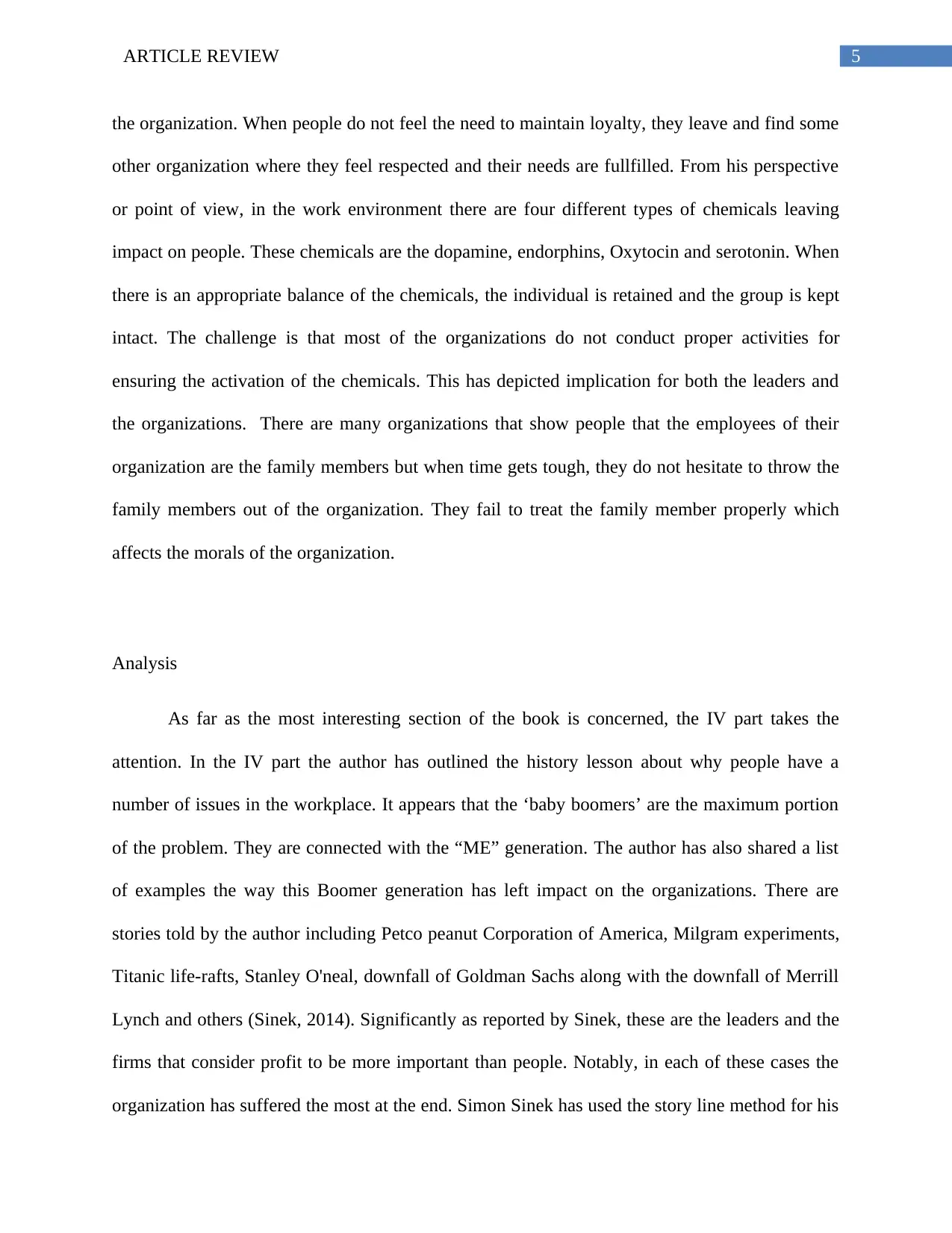
5ARTICLE REVIEW
the organization. When people do not feel the need to maintain loyalty, they leave and find some
other organization where they feel respected and their needs are fullfilled. From his perspective
or point of view, in the work environment there are four different types of chemicals leaving
impact on people. These chemicals are the dopamine, endorphins, Oxytocin and serotonin. When
there is an appropriate balance of the chemicals, the individual is retained and the group is kept
intact. The challenge is that most of the organizations do not conduct proper activities for
ensuring the activation of the chemicals. This has depicted implication for both the leaders and
the organizations. There are many organizations that show people that the employees of their
organization are the family members but when time gets tough, they do not hesitate to throw the
family members out of the organization. They fail to treat the family member properly which
affects the morals of the organization.
Analysis
As far as the most interesting section of the book is concerned, the IV part takes the
attention. In the IV part the author has outlined the history lesson about why people have a
number of issues in the workplace. It appears that the ‘baby boomers’ are the maximum portion
of the problem. They are connected with the “ME” generation. The author has also shared a list
of examples the way this Boomer generation has left impact on the organizations. There are
stories told by the author including Petco peanut Corporation of America, Milgram experiments,
Titanic life-rafts, Stanley O'neal, downfall of Goldman Sachs along with the downfall of Merrill
Lynch and others (Sinek, 2014). Significantly as reported by Sinek, these are the leaders and the
firms that consider profit to be more important than people. Notably, in each of these cases the
organization has suffered the most at the end. Simon Sinek has used the story line method for his
the organization. When people do not feel the need to maintain loyalty, they leave and find some
other organization where they feel respected and their needs are fullfilled. From his perspective
or point of view, in the work environment there are four different types of chemicals leaving
impact on people. These chemicals are the dopamine, endorphins, Oxytocin and serotonin. When
there is an appropriate balance of the chemicals, the individual is retained and the group is kept
intact. The challenge is that most of the organizations do not conduct proper activities for
ensuring the activation of the chemicals. This has depicted implication for both the leaders and
the organizations. There are many organizations that show people that the employees of their
organization are the family members but when time gets tough, they do not hesitate to throw the
family members out of the organization. They fail to treat the family member properly which
affects the morals of the organization.
Analysis
As far as the most interesting section of the book is concerned, the IV part takes the
attention. In the IV part the author has outlined the history lesson about why people have a
number of issues in the workplace. It appears that the ‘baby boomers’ are the maximum portion
of the problem. They are connected with the “ME” generation. The author has also shared a list
of examples the way this Boomer generation has left impact on the organizations. There are
stories told by the author including Petco peanut Corporation of America, Milgram experiments,
Titanic life-rafts, Stanley O'neal, downfall of Goldman Sachs along with the downfall of Merrill
Lynch and others (Sinek, 2014). Significantly as reported by Sinek, these are the leaders and the
firms that consider profit to be more important than people. Notably, in each of these cases the
organization has suffered the most at the end. Simon Sinek has used the story line method for his
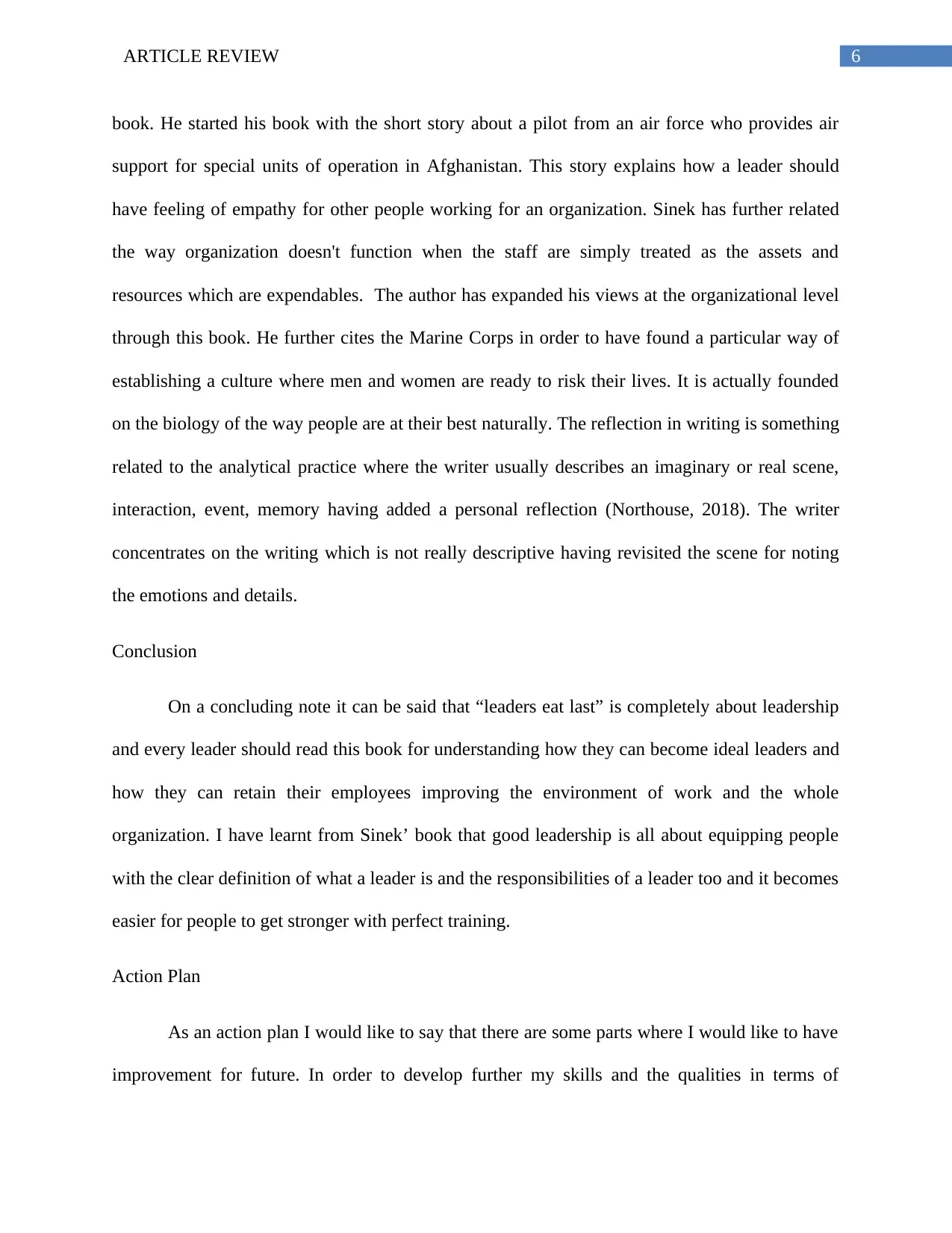
6ARTICLE REVIEW
book. He started his book with the short story about a pilot from an air force who provides air
support for special units of operation in Afghanistan. This story explains how a leader should
have feeling of empathy for other people working for an organization. Sinek has further related
the way organization doesn't function when the staff are simply treated as the assets and
resources which are expendables. The author has expanded his views at the organizational level
through this book. He further cites the Marine Corps in order to have found a particular way of
establishing a culture where men and women are ready to risk their lives. It is actually founded
on the biology of the way people are at their best naturally. The reflection in writing is something
related to the analytical practice where the writer usually describes an imaginary or real scene,
interaction, event, memory having added a personal reflection (Northouse, 2018). The writer
concentrates on the writing which is not really descriptive having revisited the scene for noting
the emotions and details.
Conclusion
On a concluding note it can be said that “leaders eat last” is completely about leadership
and every leader should read this book for understanding how they can become ideal leaders and
how they can retain their employees improving the environment of work and the whole
organization. I have learnt from Sinek’ book that good leadership is all about equipping people
with the clear definition of what a leader is and the responsibilities of a leader too and it becomes
easier for people to get stronger with perfect training.
Action Plan
As an action plan I would like to say that there are some parts where I would like to have
improvement for future. In order to develop further my skills and the qualities in terms of
book. He started his book with the short story about a pilot from an air force who provides air
support for special units of operation in Afghanistan. This story explains how a leader should
have feeling of empathy for other people working for an organization. Sinek has further related
the way organization doesn't function when the staff are simply treated as the assets and
resources which are expendables. The author has expanded his views at the organizational level
through this book. He further cites the Marine Corps in order to have found a particular way of
establishing a culture where men and women are ready to risk their lives. It is actually founded
on the biology of the way people are at their best naturally. The reflection in writing is something
related to the analytical practice where the writer usually describes an imaginary or real scene,
interaction, event, memory having added a personal reflection (Northouse, 2018). The writer
concentrates on the writing which is not really descriptive having revisited the scene for noting
the emotions and details.
Conclusion
On a concluding note it can be said that “leaders eat last” is completely about leadership
and every leader should read this book for understanding how they can become ideal leaders and
how they can retain their employees improving the environment of work and the whole
organization. I have learnt from Sinek’ book that good leadership is all about equipping people
with the clear definition of what a leader is and the responsibilities of a leader too and it becomes
easier for people to get stronger with perfect training.
Action Plan
As an action plan I would like to say that there are some parts where I would like to have
improvement for future. In order to develop further my skills and the qualities in terms of
Paraphrase This Document
Need a fresh take? Get an instant paraphrase of this document with our AI Paraphraser
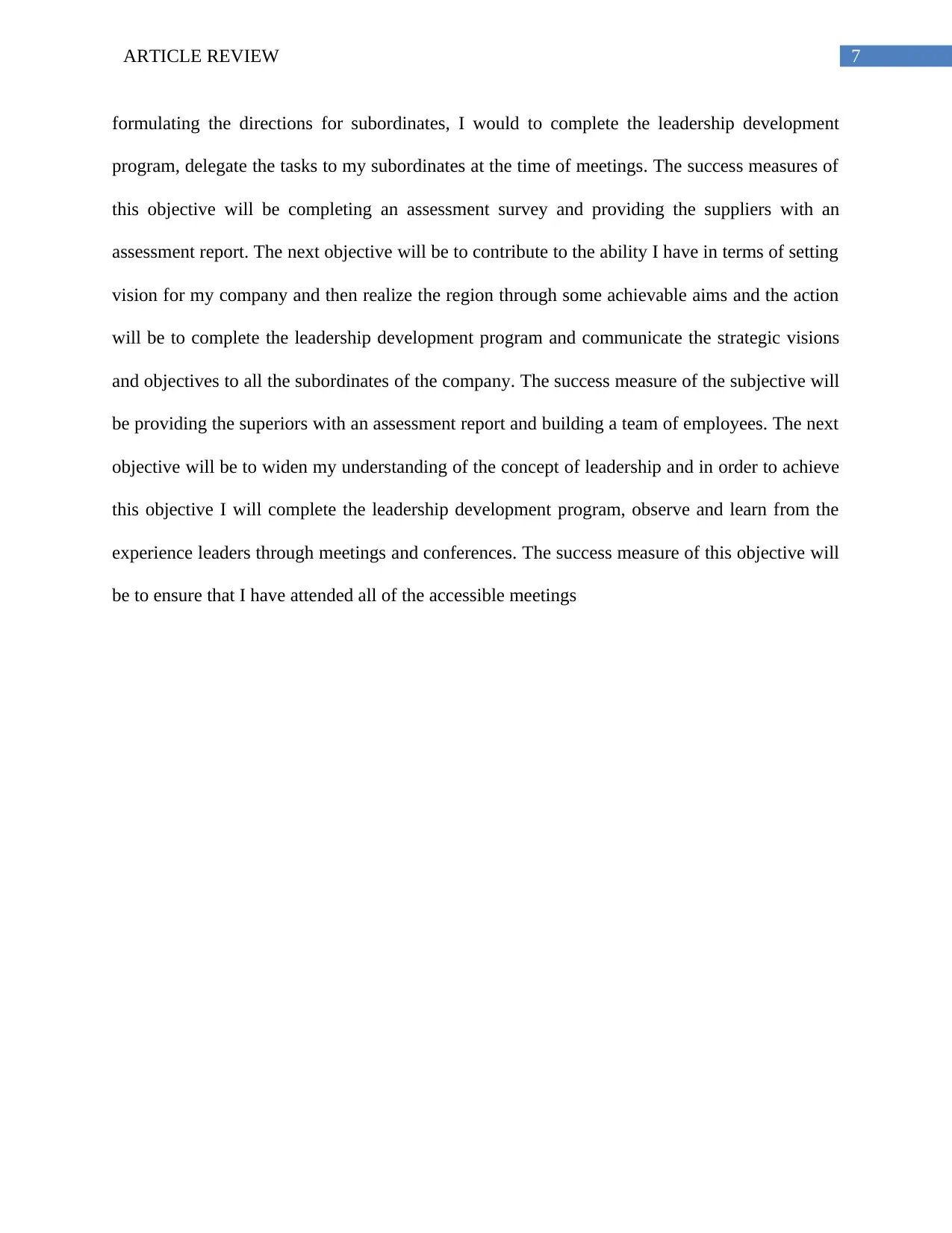
7ARTICLE REVIEW
formulating the directions for subordinates, I would to complete the leadership development
program, delegate the tasks to my subordinates at the time of meetings. The success measures of
this objective will be completing an assessment survey and providing the suppliers with an
assessment report. The next objective will be to contribute to the ability I have in terms of setting
vision for my company and then realize the region through some achievable aims and the action
will be to complete the leadership development program and communicate the strategic visions
and objectives to all the subordinates of the company. The success measure of the subjective will
be providing the superiors with an assessment report and building a team of employees. The next
objective will be to widen my understanding of the concept of leadership and in order to achieve
this objective I will complete the leadership development program, observe and learn from the
experience leaders through meetings and conferences. The success measure of this objective will
be to ensure that I have attended all of the accessible meetings
formulating the directions for subordinates, I would to complete the leadership development
program, delegate the tasks to my subordinates at the time of meetings. The success measures of
this objective will be completing an assessment survey and providing the suppliers with an
assessment report. The next objective will be to contribute to the ability I have in terms of setting
vision for my company and then realize the region through some achievable aims and the action
will be to complete the leadership development program and communicate the strategic visions
and objectives to all the subordinates of the company. The success measure of the subjective will
be providing the superiors with an assessment report and building a team of employees. The next
objective will be to widen my understanding of the concept of leadership and in order to achieve
this objective I will complete the leadership development program, observe and learn from the
experience leaders through meetings and conferences. The success measure of this objective will
be to ensure that I have attended all of the accessible meetings
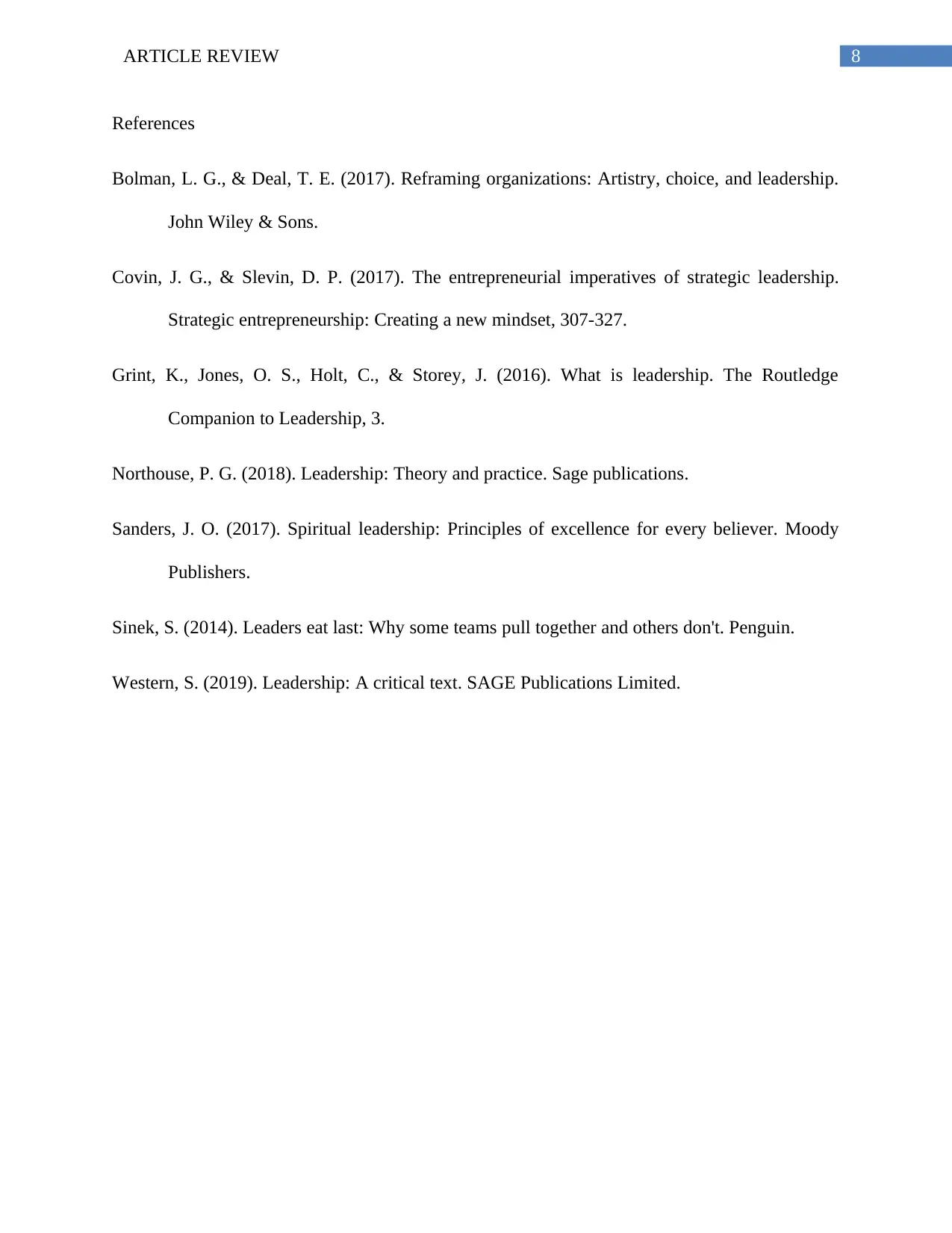
8ARTICLE REVIEW
References
Bolman, L. G., & Deal, T. E. (2017). Reframing organizations: Artistry, choice, and leadership.
John Wiley & Sons.
Covin, J. G., & Slevin, D. P. (2017). The entrepreneurial imperatives of strategic leadership.
Strategic entrepreneurship: Creating a new mindset, 307-327.
Grint, K., Jones, O. S., Holt, C., & Storey, J. (2016). What is leadership. The Routledge
Companion to Leadership, 3.
Northouse, P. G. (2018). Leadership: Theory and practice. Sage publications.
Sanders, J. O. (2017). Spiritual leadership: Principles of excellence for every believer. Moody
Publishers.
Sinek, S. (2014). Leaders eat last: Why some teams pull together and others don't. Penguin.
Western, S. (2019). Leadership: A critical text. SAGE Publications Limited.
References
Bolman, L. G., & Deal, T. E. (2017). Reframing organizations: Artistry, choice, and leadership.
John Wiley & Sons.
Covin, J. G., & Slevin, D. P. (2017). The entrepreneurial imperatives of strategic leadership.
Strategic entrepreneurship: Creating a new mindset, 307-327.
Grint, K., Jones, O. S., Holt, C., & Storey, J. (2016). What is leadership. The Routledge
Companion to Leadership, 3.
Northouse, P. G. (2018). Leadership: Theory and practice. Sage publications.
Sanders, J. O. (2017). Spiritual leadership: Principles of excellence for every believer. Moody
Publishers.
Sinek, S. (2014). Leaders eat last: Why some teams pull together and others don't. Penguin.
Western, S. (2019). Leadership: A critical text. SAGE Publications Limited.
1 out of 9
Related Documents
Your All-in-One AI-Powered Toolkit for Academic Success.
+13062052269
info@desklib.com
Available 24*7 on WhatsApp / Email
![[object Object]](/_next/static/media/star-bottom.7253800d.svg)
Unlock your academic potential
© 2024 | Zucol Services PVT LTD | All rights reserved.




